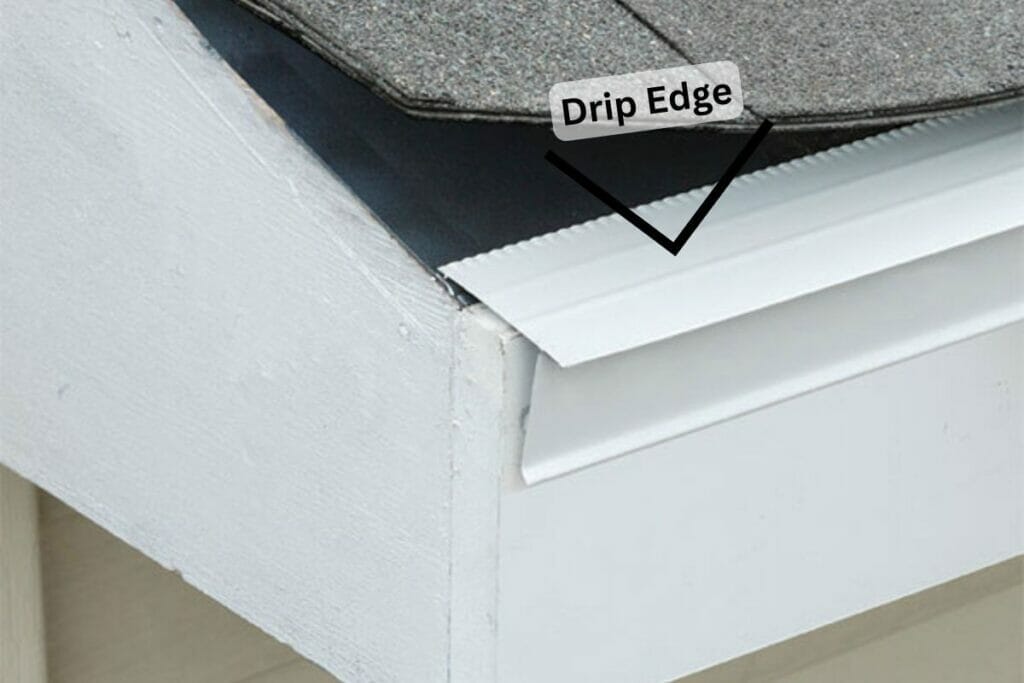Drip edges are metal strips that are installed along the roofline. It’s a good idea to install drip edges as they help protect your home from water damage. However, many homeowners wonder if it’s necessary to install them. So, if you want to know whether a drip edge is required by code in your area, we’re here to help you find the answer.
At North Star Roofing, we aim to provide our customers and community with accurate information about their home improvement needs. In this article, we’ll explain whether your home needs drip edges, how they function, and what their importance is.
Do You Need A Drip Edge On A Roof?
Well, this depends on where you live, as building codes are not the same everywhere. If you live in a region that implements the International Residential Codes (IRC), it is necessary to have drip edges installed on your home’s roof. According to the International Residential Code, a drip edge is necessary for shingle roofing systems. This amendment was made to the 2018 code, the latest edition of the IRC.
However, some areas have their own building codes that may differ from the international code. If this is the case, then your local building code may or may not require drip edges. Look up your area’s building code and read any sections regarding roof assemblies and rooftop structures, if you can find them. It will include information on necessary roofing materials and product criteria that meet the standard safety requirements. You will also find information about drip edges in this section of your local residential codes.
At North Star Roofing, we are well-informed on the building codes in the state of Pennsylvania. So, if you’re a homeowner in the Keystone State, let’s find out if a drip edge is necessary for our area.
Is A Roof Drip Edge Required In Pennsylvania?

Yes, drip edges are required by the Pennsylvania Building Code. A drip edge is installed between the starter shingles and underlayment. If your home has an asphalt shingle roof, you need to install drip edges at the eaves and gables of your roof.
Here are some installation requirements given in the code:
- A drip edge should be mechanically fastened a maximum of 12 inches in the center.
- The overlap should be a minimum of 2 inches.
- The drip edges along the eaves of a roof should extend 0.25 inches below the sheathing and a minimum of 2 inches back on the roof.
Since drip edges go below the starter shingles, their installation requires lifting up those shingles and reinstalling them after the drip edge is installed. This may seem like a lot of work, but it can actually save you money and trouble during harsh weather conditions.
That’s why a drip edge is required by code in many parts of the United States.
Let’s look at the benefits of having a drip edge on your roof.
Roof Drip Edge: Meaning & Function
A drip edge on a roof is metal flashing that is installed at the roofline of pitched, as well as flat and low-slope roofs. For pitched roofs, the drip edge prevents water from slipping behind the shingles and into the roof deck.
Drip edges function by channeling away rainwater, wind-driven droplets, melted snow, or ice directly into the gutters. Drip edges are usually made of metals like galvanized steel, aluminum, copper, and zinc. They come in different shapes and sizes to fit particular roof and gutter designs in order to offer maximum protection.
Advantages Of Drip Edges: What Homeowners Need To Know
Along with protection from water damage, drip edges can also help you save money and prevent other issues with the roofing system. Here are seven ways a drip edge guards your home from water damage and offers more benefits to homeowners:
#1 This metal strip directs rainwater away from the fascia and into the gutters, preventing water damage to your home’s foundation and walls.
#2 The drip edge protects the soffit or exposed rafters from droplets that can enter during wind-driven rain.
#3 It helps keep your porch and basement dry.
#4 Some types of drip edges can seal the “carpenter’s gap,” which is a space at the bottom of the roof that allows small animals and pests to enter the attic.
#5 Drip edges can also increase your home’s energy efficiency by preventing air drafts.
#6 A drip edge is a protective but often ignored roofing material. If you have drip edges on your roof, your insurance company may consider that you follow proper building codes and roof maintenance.
#7 If you plan to sell your home in the future, your home appraiser may also appreciate seeing drip edges during an evaluation.
Now you know why a drip edge is necessary for your roofing system. If you want to install this type of metal flashing on your roof we’ll share some guidelines below, which were prepared by our experts to ensure proper installation.
Drip Edge Installation Requirements
Since this roofline flashing requires working around the shingles and underlayment, homeowners often wonder if it is okay to install them on an existing roof.
If you’re also wondering the same, here are six expert tips to ensure the proper installation of drip edges:
#1 A drip edge can be installed anytime. It does not disturb all the shingles, only the starter shingles. But mostly, the installation is done as part of a roof repair, remodel, or replacement project on an existing roof.
#2 Drip edge installation is quick and inexpensive, so you don’t need to worry much about the expense. You just need to hire a reliable roofing professional who can do it perfectly.
#3 There are different types of drip edge profiles and materials available on the market. You need to choose the right one for your home based on your roofing material, gutters, local weather conditions, and other aspects.
#4 If you live near the coast or a lake, aluminum is the right material for drip edges. It will not corrode due to salty and humid weather conditions in the area.
#5 A Drip edge is required by code, which also states how to install it. Drip edge installation is a careful roofing job that should be done by a licensed and experienced roofing contractor. Otherwise, a faulty installation is as good as no drip edge.
#6 A shoddy job can also damage the shingles or cause you to lose a warranty in the process. So, it’s crucial to select the best roofing contractor in your area to complete this job.
If you live in Pennsylvania and want to install a drip edge or need more roofing services, we can help you.
Free Consultations & Estimates For Homeowners
At North Star Roofing, we’re proud to be a part of the Pennsylvanian community. Our experts have been serving the area with utmost care and exceptional roofing services for years! We understand that your home is your most valuable asset, and you want to protect it along with your family. That’s why we offer free consultations and estimates to all homeowners in the area. We take pride in our work and are committed to providing you with the highest quality service possible.
If you want to discuss drip edge installation or other residential roofing services, reach out to us at (484) 302-7663. Our experts will work with you to find the best roofing solution for your home!


